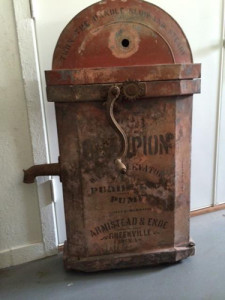
This water elevator was used on the southeast corner of the Hunt County Courthouse Square, primarily to water livestock and put out fires in the late 1890s. It drew water out of a cistern underneath. (Author’s collection)
After the wonderful rains, spring seems to be even lovelier than ever. What a miracle raindrops perform. While looking for something else, as I frequently do, I found some interesting old newspaper articles about the water situation in Greenville from 1846 when the town was established until 1899. More than 100 years later, the situation seems comical, even though it was desperate at the time.
Work on the first courthouse began in the spring of 1847 after town lots were sold to pay for the construction. In an effort to be very modern, the powers that were decided to dig a well on the southeast corner of the public square. They hit water, but it tasted awful. So townspeople went down to the banks of Cowleach Creek and hauled water home. One local attorney wrote that in critical dry spells, wild animals and human beings were glad to share the same waterhole.
In 1881 the newly incorporated town dug public cisterns at four spots around the square. Private homes already had cisterns at the corner of the houses to catch rainwater. The public cisterns were primarily used for fires and watering livestock.
In 1888, Greenville was becoming such a modern place they decided to purchase water from the newly formed Greenville Water and Electric Company. J. M. Cook was president of the organization. The company built a dam across Cowleach Creek north of downtown. A “stand pipe” or water tower stood 137 feet in the air to facilitate the flow of water by gravity through town. In 1889 the company unveiled the new system by shooting a stream of water over the courthouse. As was customary for Greenville, the celebration included a barbecue, band concerts, a lengthy speech by the US Congressman, and two formal balls that evening.
The system worked as well as any other in North Texas. However, as with any business run on credit, it was often difficult to collect water bills. Ten years later the company sold at public auction for $31,000 to a New York City firm. As the bidder left the auction, he stated that his company would evaluate the situation to determine if it were “worthy of operating.” A local group barely missed buying Greenville Water and Electric Company. W. L. Beckham, F. J. Phillips, W. A. Williams, S. A. Beckham, and J. B. Clayton submitted a bid of $30,500, some $500 short.
By December the mayor of Greenville announced that since the water plant was working so well, it was time to proceed to complete the sewer connections for a new sewer line.
As the finances of the old water company were sagging, someone suggested drilling for artesian wells, a popular solution all over the area. One was bored south of downtown, struck mineral water, and became a popular park known as Mineral Heights. The Greenville Messenger editors suggested establishing a brewery and forgetting about drinking water that summer. Needless to say, that was not a popular idea in a town full of prohibitionists.
While the New York Company under Mr. Street attempted to make a success of Greenville Water and Power Company, the City of Greenville bought the plant in 1909 for $92,500. As a side note, the company never produced a watt of electricity. Greenville Electric Light Company, always owned by the city, began production of electricity on March 4, 1891. That’s a whole different story, though.
